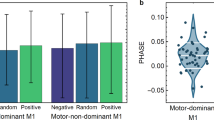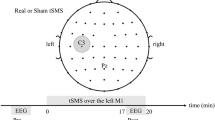Abstract.
To clarify the cortical mechanisms involved in motor inhibition, modulation of cortical rhythms around 20 Hz during voluntary muscle relaxation was compared to that during muscle contraction in ten normal volunteers, using a whole head type neuromagnetometer. Each subject relaxed or contracted the right forearm muscles, from which electromyograms were recorded. After band-pass filtering magnetoencephalographic signals into frequency bands of 6–10, 10–14, 14–18, 18–22, 22–26, and 26–30 Hz, the signals of each frequency band were rectified and averaged with respect to the onset of motor trial. The relaxation task showed movement-related 20-Hz desynchronization over bilateral central areas beginning a few seconds before the termination of muscle contraction. Twenty-hertz desynchronization was present also for the contraction task at the same location within each subject. The two tasks had a positive correlation among subjects in both the percent decrease (r 2=0.76, P<0.01) and the peak time (r 2=0.61, P<0.05) for the contralateral 20-Hz desynchronization. After the muscle relaxation, desynchronization was followed by conspicuous movement-related synchronization of the 20-Hz passband in the contralateral central areas, which was significantly larger than that after the contraction (P<0.001). The results suggest that the voluntary muscle relaxation involves the modulation of central rhythms starting a few seconds before the actual event, and the 20-Hz desynchronization has a similar temporal property in the muscle relaxation and contraction. The 20-Hz synchronization in the contralateral central area after the muscle relaxation may be associated with the temporally arrayed termination of the ongoing muscle contraction.
Similar content being viewed by others
Author information
Authors and Affiliations
Additional information
Electronic Publication
Rights and permissions
About this article
Cite this article
Toma, K., Nagamine, T., Yazawa, S. et al. Desynchronization and synchronization of central 20-Hz rhythms associated with voluntary muscle relaxation: a magnetoencephalographic study. Exp Brain Res 134, 417–425 (2000). https://doi.org/10.1007/s002210000483
Received:
Accepted:
Issue Date:
DOI: https://doi.org/10.1007/s002210000483




